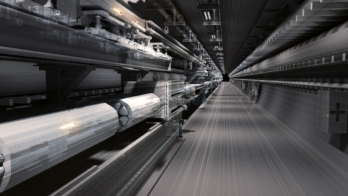A recent review by the Canadian subatomic-physics community has identified the main priorites for the coming years for research in nuclear and particle physics in Canada.
As in many other countries and regions, the Canadian subatomic-physics community has recently completed an in-depth study of its strengths in particle and nuclear physics, and has developed a focused Long Range Plan (LRP) for the coming decade. While primarily focusing on the community’s scientific goals, the planning process compiled a list of the economic and training benefits that have resulted from research in subatomic physics and took stock of the extraordinary financial resources that have been available over the past decade. Operating with a budget surplus for much of that time, the Canadian government has invested heavily in all areas of fundamental research, including subatomic physics. Recent studies by the Organisation for Economic Co-operation and Development (OECD) show that these investments have moved Canada to the top of the G8 in public funding per capita for scientific research (OECD 2003). Some of this funding has targeted the hiring of top researchers at Canadian universities, but much of it has rejuvenated research infrastructure in Canada – including the construction of the Sudbury Neutrino Observatory (SNO) and the funding of Canada’s Tier-1 LHC computing centre.
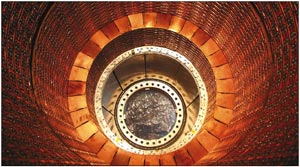
Image credit: Roy Langstaff, University of Victoria/TRIUMF.
While there are many similarities between the Canadian LRP and others recently released, there is one important difference. Particle and nuclear physics receive joint funding in Canada not only for university-based researchers – who are funded by the Natural Sciences and Engineering Research Council (NSERC), the sponsor of the LRP process – but also for TRIUMF, the national laboratory for particle and nuclear physics. The LRP balances Canadian priorities for particle and nuclear physics in the coming decade. The five priorities that the plan identifies are seen as crucial if the Canadian subatomic-physics community is to build on its recent successes (see box 1). These five priorities encompass the main research activities of more than three-quarters of the experimental subatomic-physics community in Canada.
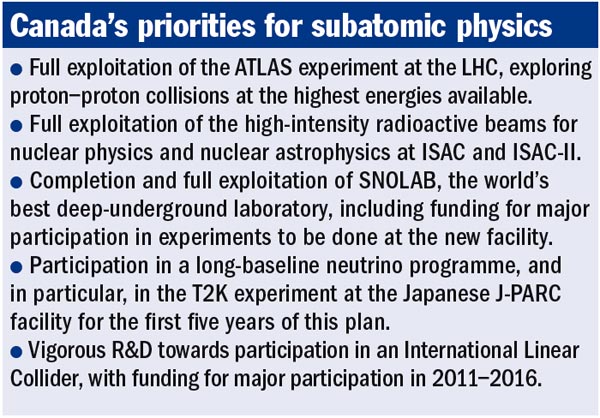
Canadian particle physicists were founding members of the ATLAS experiment at CERN’s LHC in the 1990s. In addition to contributing major pieces of the hadronic endcap and forward calorimeters, Canada, through TRIUMF, has made important in-kind contributions to refurbishing the CERN proton-injector complex. Canadians are now leading commissioning efforts for the ATLAS calorimeter and are preparing for in situ calibrations using the initial data expected later this year. A growing contingent of recently hired faculty, bringing their experience from Fermilab’s Tevatron, are contributing to the ATLAS high-level trigger system – crucial to the extraction of LHC physics. At home, researchers are taking full advantage of the state-of-the-art Canadian computer network infrastructure, integrating the operations of our Tier-1 centre at TRIUMF with those of our Tier-2 centres in Toronto/Montreal and Vancouver/Victoria. The high profile of ATLAS attracts the best graduate students and also serves as a focal point, bringing together Canadian theorists and experimentalists as they prepare to unravel the LHC phenomenology. The LRP prioritizes the support of these researchers to capitalize on Canada’s investment in the LHC programme. In addition to preparations for initial ATLAS physics the LRP anticipates a continued involvement and proposes that significant funding be made available for upgrades to the LHC and ATLAS in the second half of the plan.
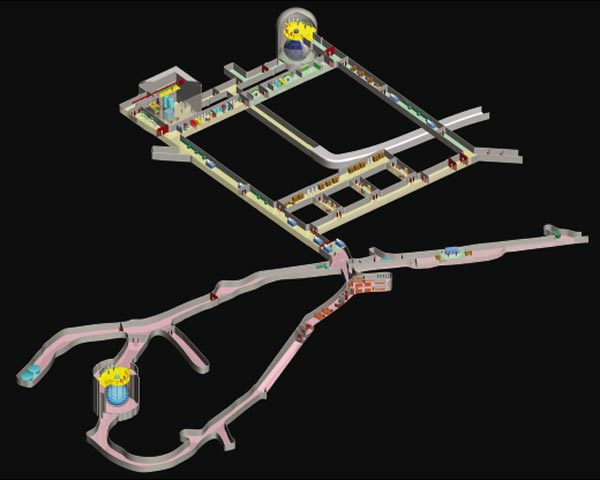
Image credit: SNOLAB.
One of the great Canadian successes of the past decade has been SNO, which has provided unequivocal evidence that electron-neutrinos produced in solar fusion oscillate into muon- and τ-neutrinos at a sufficient rate to explain the long-standing solar-neutrino deficit (see SNO: solving the mystery of the missing neutrinos). As a result of this great success the Canadian government has funded the expansion of the SNO experimental facilities. The new SNOLAB infrastructure is almost complete, nearly tripling the floor space for experiments and generating significant interest from researchers in underground physics from around the world. Out of twenty expressions of interest for SNOLAB experiments, nine are still being vetted for first-round space in the new laboratory.
The main scientific goals include searches for dark matter, neutrino-less double beta decay and the study of lower energy solar and geo-neutrinos. With such a world-class facility in Canada, the LRP prioritizes support for Canadian researchers to lead the construction of one or more major experiments. The SNO+ experiment has an advanced engineering design to replace the heavy water in SNO with liquid scintillator to allow the study of neutrinos from the solar “pep” chain. It may also be possible to dope the scintillator with enriched neodinium, making SNO+ a competitive neutrino-less double beta-decay detector. The DEAP/CLEAN experiment is at prototype stage, exploiting the novel signal properties of dark matter in liquid argon and neon. First-round experiments are expected to begin before the end of the decade.

Image credit: TRIUMF.
Canadian subatomic physicists are also at the forefront of the study of nuclear astrophysics and the quest to understand the basic hadronic building block of nature – the nucleus – using radio-active beams at TRIUMF’s Isotope Separator and Accelerator Complex (ISAC). The ISAC facility delivers some of the world’s most intense rare beams using the world’s highest power on target (up to 50 kW). One highlight was an experiment with 21Na that provided incisive measurements, refining our understanding of stellar evolution and modelling nuclear synthesis. The new ISAC-II facility extends the accelerator to 12 MeV for each nucleon using superconducting RF cavities. The first experiment, using 11Li (t1/2 = 8 ms), was carried out in December 2006: a European, US and Canadian collaboration investigated the unexpected behaviour of this halo nucleus.
The unique capabilities of ISAC and ISAC-II, including state-of-the-art instrumentation, make this the prime location for a worldwide user network; however, it is configured as a single-user facility. There is contention for beam time between the first-rate science programme and the development of new targets and ion sources. To alleviate this, the LRP prioritizes the full exploitation of ISAC and ISAC-II and the development of a second isotope production line.
TRIUMF is also the nexus for Canada’s contribution to the Tokai-to-Kamioka (T2K) project in Japan. With its expertise in remote target handling, developed at ISAC, TRIUMF is consulting on the T2K neutrino-beam target station. Canadian researchers are leading the construction of the T2K near detector, building modules of the time projection chamber tracker, as well as the fine-grained calorimeter.
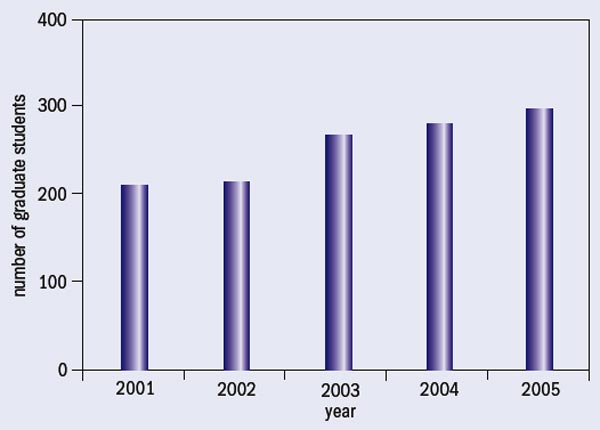
Image credit: Canadian Long Range Plan committee.
The LRP identified a further future priority, foreseeing a fully fledged Canadian participation in an International Linear Collider. TRIUMF accelerator physicists are already engaged in the ILC Global Design Effort. Members of the Canadian subatomic-physics community are working to identify industrial partners and are encouraging them to become full participants in the North American ILC industrial forum. Canadian university-based researchers have a long history of important contributions to electron–positron collider experiments, including the OPAL experiment at CERN’s LEP and more recently the BaBar experiment at SLAC. These researchers have been actively engaged in Canadian detector R&D efforts for ILC detectors.
The Canadian subatomic-physics community has seen significant growth this century. As a result of targeted hiring and replacing retiring faculty, 35% of the subatomic-physics faculty in Canada has been hired in the past six years. A 45% surge in the number of graduate students has accompanied this faculty renewal. Further growth is anticipated as the new faculty members establish their research programmes and recruit their full complement of students and postdoctoral researchers. This growth in subatomic-physics graduate student numbers appears to be counter to the experience in other OECD nations, and bodes well for subatomic physics in Canada.
The LRP Committee has therefore found that subatomic physics in Canada is strong and healthy, but the news is not all good. Despite the significant infusion of capital from the government’s novel funding mechanisms, support for traditional sources of sub-atomic physics in Canada have not kept pace with inflation over the past 10 years. The growth and renewal in the community has put ever increasing pressure on the ongoing operational support. One main goal of the LRP exercise was to identify and quantify these pressures, so as to provide a firmer basis for requests for increased operational support for fundamental research in general and subatomic physics in particular.
Further reading
The LRP report and more details are at www.subatomicphysics.ca.
OECD 2003 Main Science and Technology Indicators.





